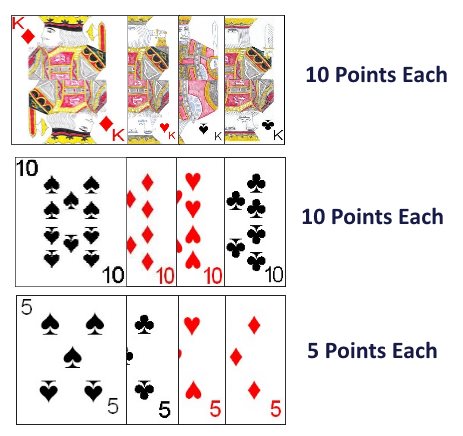Sheng Ji: Sheng Ji appears to be the parent game of Zhao Pengyou, with both games having been derived from Da Bai Fen (see the rules for Da Bai Fen detailed below). Sheng Ji is
designed to be played by four players in two fixed partnerships. Sheng Ji uses two standard decks, including
a total of four Jokers. Two of the Jokers should be color (or Red) and
the other two black and white. This game is also known as Tuo La Ji
(translated as Tractor) or Bashi Fen. Sheng Ji is also the general name
given to most games of this type, and translates, in English, as "Raise Level".
Since Sheng Ji features fixed partnerships, before start of the game, the members of each partnership should be determined. If there is any dispute as to these partnerships, this can be done by all players drawing a card from the shuffled, face-down deck. The players drawing the two highest cards would play as partners opposed to the players drawing the two lowest cards. The player who draw the highest card of all should be set as the player to draw the first card to begin the draw portion of the game. The partners should sit directly across the table from each other such that play during the hand alternates directly between players from opposing partnerships.
As in Zhao Pengyou, each partnership has a special rank that advances from two
to Ace during the hand as well as a specific status of Active or
Passive. At the start of the game, each partnership starts with a
ranking of Active Two. The first player, over the course of the game to exceed the ranking of Ace
is declared the winner.

The draw is the same as in Zhao Pengyou, with the players drawing one card from the face-down pack in a counter-clockwise direction around the table until each player has a total of 25 cards. The remaining 8 cards are set face-down in the center of the table as a reserve. In the first round of each game, the first player to
receive and who elects to place a card equal to his current score (in this case any two) is given the title of dealer and Declarer for the hand. The suit (and rank) of the card exposed sets the trump "suit" for this first hand. After the first hand, the Declarer and Dealer is dependent on whether the current Declarer won or lost points during the last round (as described below). However, the trump "suit" for the hand is still determined by the first player to expose a card from his growing hand onto the table that is equal to his current score ranking. The suit and rank of this card will determine the trump suit for this hand. However, as in the standard game, if another player wants to change to a different trump suit for the hand, he may do so only by playing two exact cards of that same rank and another suit to cancel out the previous play, setting this new suit as the trump suit for the hand. If, after all players have drawn the necessary 25 cards into his hand and no player places a card to set the trump suit for the hand, the top card of the Kitty is exposed. The card exposed is used to determine the trump suit (with the card exposed setting the suit to be used as the trump suit during the hand). In any event, regardless of the actual numerical rank of the card exposed, the current score of the Declarer's team is set as the trump ranking for the hand. If the exposed card is a Joker, the next card is exposed from the Kitty.
After the players have each drawn the requisite 25 cards and the trump suit has been set for the hand, the player who currently has the rank of Dealer takes the remaining 8 cards from the center of the table into his hand. He then discards any 8 cards from his hand and places them face-down on the table to form the Kitty. These cards are not used again until the end of the game where any point scoring cards found in this Kitty will be added to the player who wins the last trick of the hand.
The Declarer and Dealer then plays the first card to the first trick. As in Zhao Pengyou, the leader to a trick has a variety of play types he can make to begin the trick:
- A single card of any rank or suit. Each subsequent player then, in a counter-clockwise direction, plays one card of their own to the trick. These players must play a card of the same suit as led if they have one. If they do not have such a card, they may play any other card from their hand, including a card of the trump suit. All cards of the selected trump rank, trump suit and all Jokers are considered to be a part of the trump suit and must be played when a play requires that of a trump suit. The highest card of the trump suit played to this trick wins the trick. If no card of the trump suit was played to the trick, the highest card of the suit originally led to the trick wins the trick. If two or more identical cards (both suit and rank) have been played to the same trick, the first of these played is considered to be the higher.
- Two cards of the exact same rank and suit (called Doubles). Each other
player must then also play two cards to this trick. If a player has two identical cards of the suit originally led to the trick, they must play these cards. If not, they must play any other two cards from this same suit, if they have them. If a player does not have two cards from the led suit he must play as many as he
does have. If he has no cards from the suit led, he may play any two cards of the same ranking from the trump suit if he has them. Otherwise the player may play any two other cards from
his hand. The trick is won by the highest group of exactly identical cards of the trump suit (if any) played to the trick. If no such cards of the trump suit were played to the trick, the trick is won by the player playing the highest group of identical cards of the suit originally led to the trick.
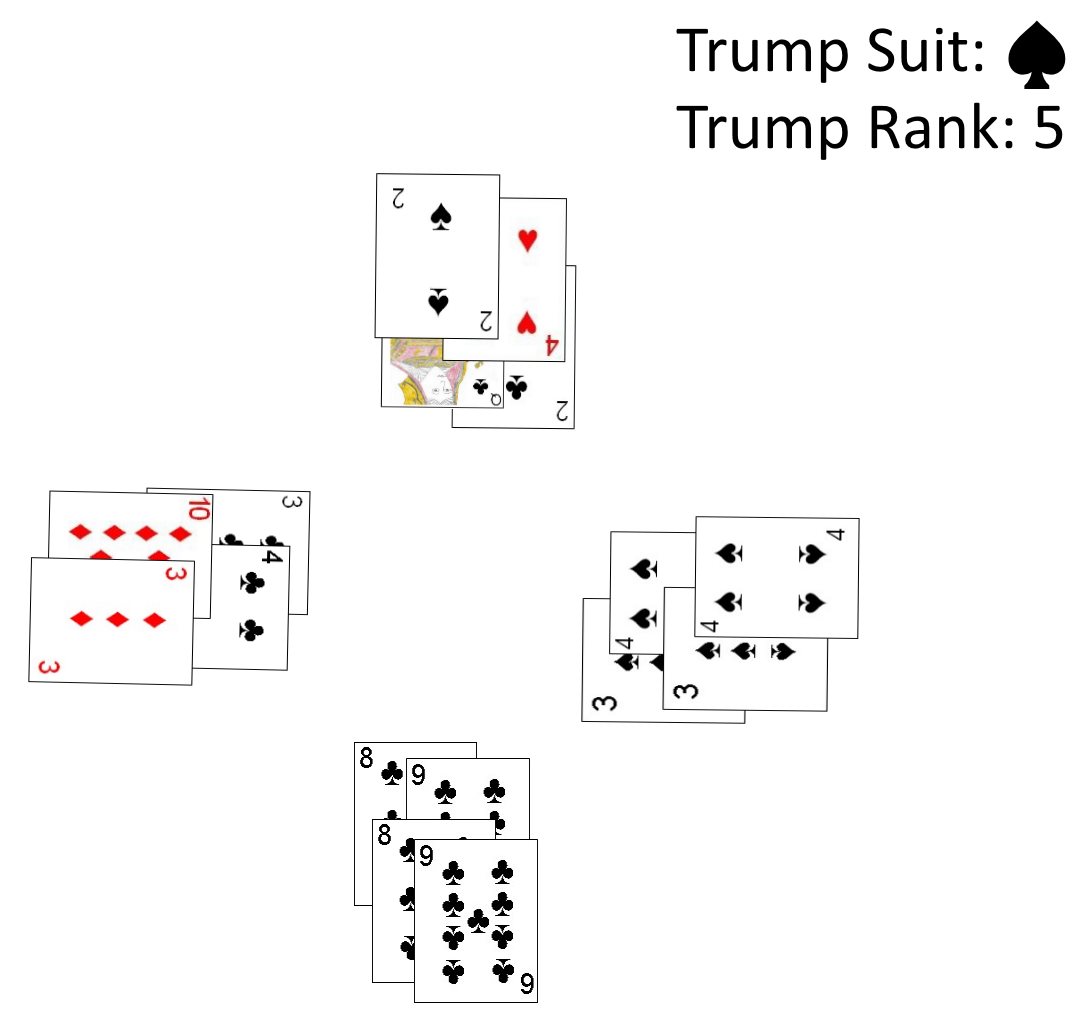
- Two or more sequential sets of two identically cards in direct numerical order. If the leader to the trick has multiple sets of identical cards in direct sequential order, he may play all such cards to this trick. Jokers and cards of the trump rank (of other suits) are not considered to be in any sequential order so may not normally be included in a play of this type. Each other player, in turn, must then play an equal number of cards to the trick. If these players have a group of sets in the suit led consisting of the same number of cards, they must play these cards to the trick. If they do not have this type of combination, they must play as many such sequential sets as the do have (if any) in that suit and then may play any other cards from the hand, starting with cards of the suit led. If the player has no cards of the suit led, they may also play an equal number of sequential pairs from the trump suit if they have such a sequence of sets. If the player does not have (or does not want to play such a set from the trump suit) and has no other cards of the suit led, he may play the same number of cards from his hand (of any other suit or rank). The trick is won by the highest sequence of sets in the trump suit played to the trick, if any. If no such sequential pairs of the trump suit were played to the trick, the trick is won by the highest sequence of sets in the same suit as led to the trick. Note that, for purposes of winning the trick, the players must play sets consisting of the exact
same number of cards as the leader to this same trick. Two sets of identical cards are known as a Tractor, from which this game gets one of it's
common names.
- Card Combinations. If a player has the current highest cards or card doubles in a particular suit, he may play all such cards at the same time to lead the trick. These may be combinations of the previous types of plays, such as individual cards, sets or sequence of sets. All cards must, however, be of the same suit. The other players must then play an equal number of cards to the trick. If possible, they must play the same number of identical cards as played by the leader to trick, and the cards must be of the same suit. If they do not have the same number of cards of the same suit, they must play as many cards as they have of that suit and any other cards from the hand to complete a play of the same number of cards. If a player has no cards of the suit led, he may play a similar combination of cards from the trump suit. If any other player has a combination that can beat a combination (in the same suit or of the trump suit) played by the leader, he must show it immediately, and the leader must change his lead, removing that combination of cards (the one exception to this rule is for a combination of sequential doubles). The player must remove the highest cards (that could not be beat from the combination, leaving the cards that could be beat by this other player). The only way to beat the entire play is if any other player, not having any cards of the suit led, is able to play the same pattern of combinations in the trump suit, which wins the hand. If two other players are able do play a combination in the trump suit, the play containing higher cards is considered the higher.
The winner of each trick then leads the first play to begin the next trick. The hand continues until all cards have been played. If the Defenders win the last trick, they add any point scoring cards from the Kitty to cards captured, doubling any points found in that hand. If the Declarers win the last trick the Kitty is set aside, with no points added to any player's score. After the last trick is played and
won, the Defender team then count the number of card points captured during the hand. As in Zhao Pengyou, each King or 10 captured by a team is worth 10 points and each 5 captures by the team is 5 points.
Points earned by a team are directly dependent on the number of card points captured by the Defenders during the hand. The following chart shows the number of points earned by which team based on this number:
| Points Captured by Defender Team | Game Points earned by Defender Team | Game Points Earned by Declarer Team |
|---|
| 0 | 0 | 3 |
| 5 to 35 | 0 | 2 |
| 40 to 75 | 0 | 1 |
| 80 to 115 | 0 | 0 |
| 120 to 155 | 1 | 0 |
| 160 to 195 | 2 | 0 |
| 200+ | 3 | 0 |
If the Declarer's manage to earn points during the hand, they retain the Declarer (or Active) title for the next hand. The player who has the role of dealer on that team, however, switches to the other player in that partnership. The same applies if neither the Declarer's team or the Defender's team earn any points during the hand. If the Defender team earns points during the hand, the Defender team becomes the Declarer team for the next hand, and the previous Declarer team becomes the Defender team. The player to the immediate right of the previous player in the dealer role takes this role for the next hand.
The first team to advance it's rank beyond "Ace" is declared the winner of the game.
Da Bai Fen: Da Bai Fen (which translates to Contesting 100 Points but which is often shortened to just Hundred) is a variant of Sheng Ji which uses one standard deck
and two Jokers (one Color and the other Black and White). The game is played identically to standard Sheng Ji with the following differences:
- One 52 card deck is used, including two Jokers. The ranking of the cards in the trump and other suits is identical as that in the Sheng Ji.
- Each player continues drawing in turn until each player has a total of 12 cards. The remaining six cards are left face-down in the center of the table.
- As in the Sheng Ji, each player may expose a card he has drawn into his hand at any time to the center of the table that is equal to his current scoring rank. The suit (and rank) of that card sets the trump suit for the hand. However, if no player has yet opted to expose such a card at the time when all the players have the requisite number of cards, the dealer then begins exposing the cards
from the Kitty one at a time. If the exposed card is of the same suit as the current trump rank (as determined by the current Declarer's team), the suit of that card then becomes the trump suit for the hand and no further cards from the Kitty are exposed. If no card of that rank is exposed from amongst the cards comprising the Kitty, the highest denomination card exposed sets the trump suit for the hand, with the trump rank still dependent on the current score ranking of the Declarer's team for the hand. If there are multiple cards of the same rank exposed, the first of these highest ranked cards sets the trump suit for the hand.
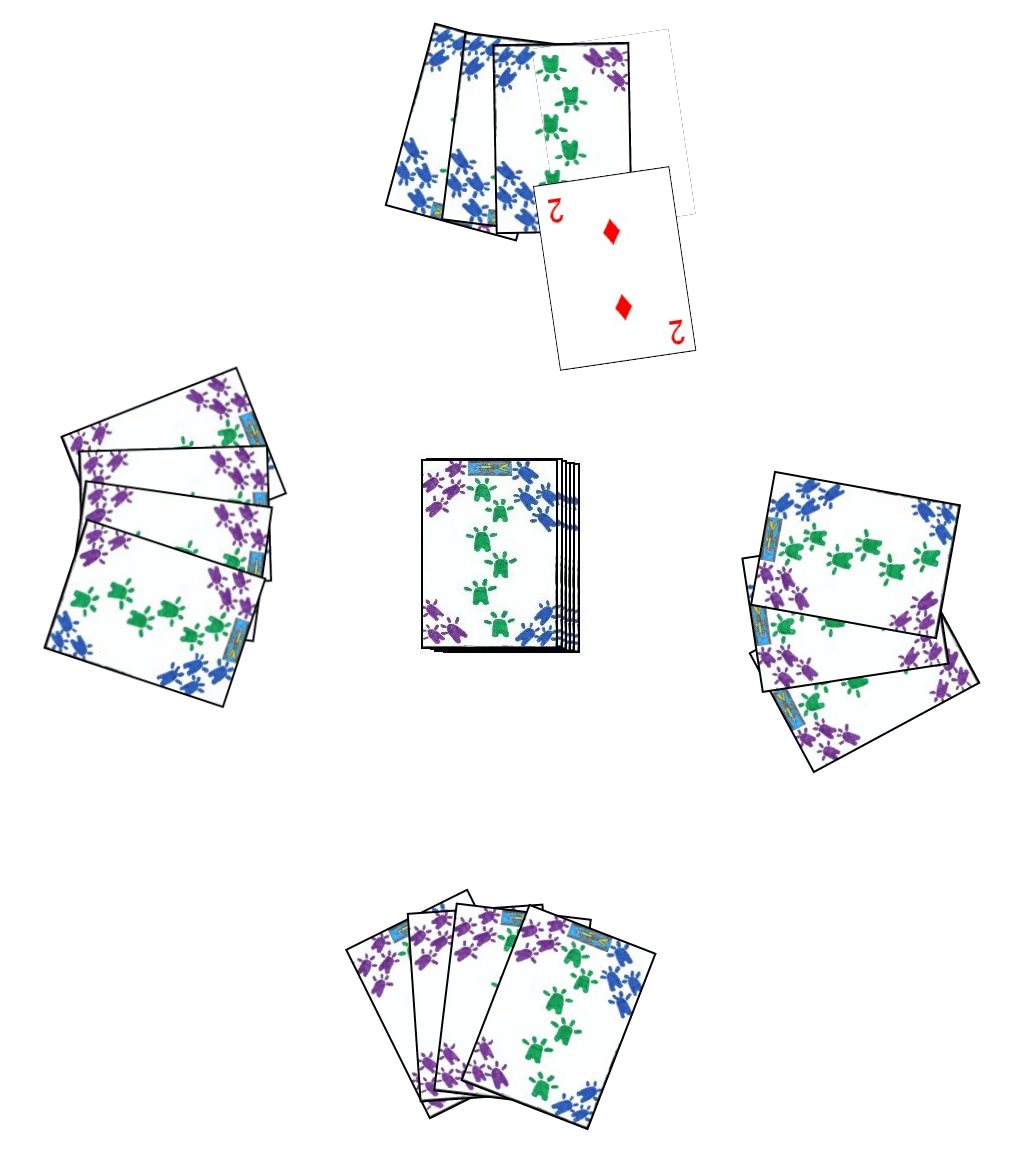
- In the first hand, the first player to expose a card matching his current score ranking (in this case a two) becomes the Dealer and Declarer for the first hand. On each subsequent hand, this is determined by the partnership who wins each hand.
- The Dealer takes the six cards of the Kitty and adds them to his own hand. He then discards an equal number of cards from his hand, face-down on the table.
- If, after determination of the trump suit, any player finds that he has no trump cards in his hand may declare this and display his hand. No score is calculated for the hand, the cards are all thrown, reshuffled and a new hand played. Whichever player so exposed his hand is automatically set as the Dealer on the next hand.
- The Declarer leads to the first trick of the hand. The legal plays to a trick are as follows:
- Single Card: The leader may play any one card from his hand to start the trick. Each other player, in turn, must play a card of the same suit if they have one. If they do not have such a card, they may play a card of any other suit, including the trump suit. The trick is won by the highest card of the trump suit played to the trick. If no card of the trump suit was played to the trick, the highest card of the suit originally led to the trick wins the trick.
- Multiple Card Combination:
The leader may play a group of multiple cards, all of the same suit. However, when doing so, all cards led by this player must be higher then any other cards still remaining in any other player's hand. If any other player (including the players own partner) has any card of the suit led higher than that led by the leader in a multi-card lead, he must show the card and the hand immediately ends, scored as if the opponents of the leader to that trick had won every trick. When this type of combination is led, each other player must play an equal number of cards as led to this trick. They must play cards of the same suit as led if possible. If they have less than this number of cards as the suit led, they must play all the cards they do have of the suit led and then add as many cards as necessary from other suits. If the player has no cards of the suit led, but has an equal number of cards of the trump suit, he may opt to play those cards. The trick is won by the highest all trump combination played to the trick. If no such combination was played to the trick, the leader to the trick wins the trick.
Whichever team wins the last trick is entitled to any point scoring cards found in the Kitty. These point scoring cards found in the Kitty score double the standard number of points.
The game points earned by the winning team is determined by the number of card points scored by the Defender team, as per the following chart:
| Points Captured by Defender Team | Game Points earned by Defender Team | Game Points Earned by Declarer Team |
|---|
| 0 | 0 | 2 |
| 5 to 35 | 0 | 1 |
| 40 to 75 | 0 | 0 |
| 80 to 95 | 1 | 0 |
| 100+ | 2 | 0 |
If the Declarer's team earns points during the hand, that team retains the role of Declarer for the next hand. The Dealer for this next hand becomes the partner of the player who was the Dealer on the last hand. If the Defenders earn points during the hand, that team becomes the Declarer for the next hand. The role of the Dealer is provided to the player to the immediate right of the previous Dealer. If neither team scores points on the hand, the Defender team becomes the Declarer team with the player to the immediate right of the previous Dealer becoming the new Dealer.
The first team to increase it's score past Ace is declared the winner of the game.
In all other respects, this game is played identically to Sheng Ji.
Copyright © 2015 CatsAtCards.com. All rights reserved.

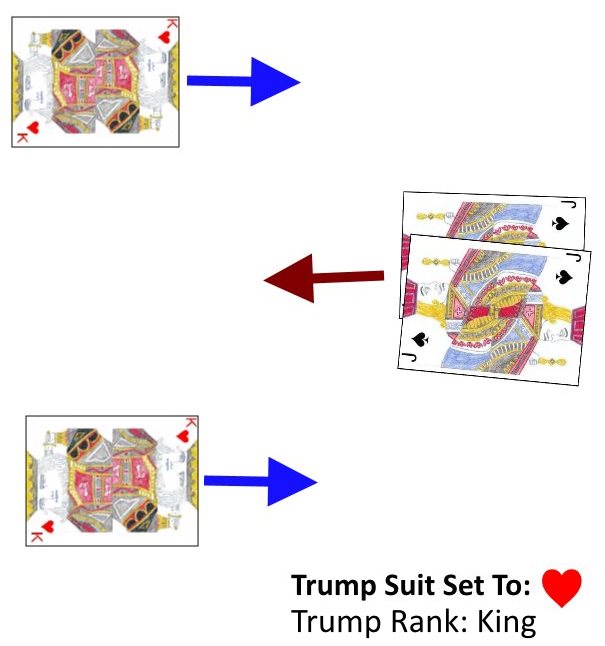 A player who currently has the "Active" modifier associated with his score can attempt to set the trump suit for the hand. He may only do this, however, if he has a card in his hand that corresponds to the rank or number of his current score. He does this by placing the card face-up on the table in front of himself, and he may do this anytime during the process of the player's drawing cards into the hand, up until the time in which the last player has drawn the last card to complete his hand. The suit of the card determines the trump suit he is proposing for the hand. Once any player places such a card, this suit will be set as the trump suit, unless another player "outbids" this player. Another
"active" player may outbid this first player by placing two identical cards which are each equal in rank to that player's own score face-up in front of himself. When another player out-bids the first player the first player has two options. He may either accept this new trump, taking his own card back into his hand. Or, he may play a second card of his own, of the same rank and suit as his first on the table, which then overrides the second players bid. In either case, a third player can then attempt to further outbid by placing three cards of the same suit, and each of the rank equal to his current score on the table in front of himself. The last high bid, may, if he has such a card, add a third card to his own set to earn the privilege of setting the trump suit. This is only possible when playing a variant in which three decks are used. Similarly, a three identical card set could be outbid by four identical cards (when four or more decks are being used).
A player who currently has the "Active" modifier associated with his score can attempt to set the trump suit for the hand. He may only do this, however, if he has a card in his hand that corresponds to the rank or number of his current score. He does this by placing the card face-up on the table in front of himself, and he may do this anytime during the process of the player's drawing cards into the hand, up until the time in which the last player has drawn the last card to complete his hand. The suit of the card determines the trump suit he is proposing for the hand. Once any player places such a card, this suit will be set as the trump suit, unless another player "outbids" this player. Another
"active" player may outbid this first player by placing two identical cards which are each equal in rank to that player's own score face-up in front of himself. When another player out-bids the first player the first player has two options. He may either accept this new trump, taking his own card back into his hand. Or, he may play a second card of his own, of the same rank and suit as his first on the table, which then overrides the second players bid. In either case, a third player can then attempt to further outbid by placing three cards of the same suit, and each of the rank equal to his current score on the table in front of himself. The last high bid, may, if he has such a card, add a third card to his own set to earn the privilege of setting the trump suit. This is only possible when playing a variant in which three decks are used. Similarly, a three identical card set could be outbid by four identical cards (when four or more decks are being used).

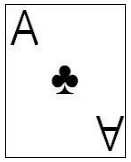
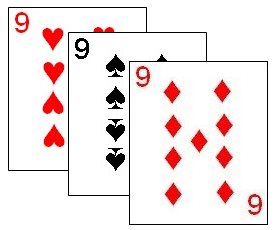
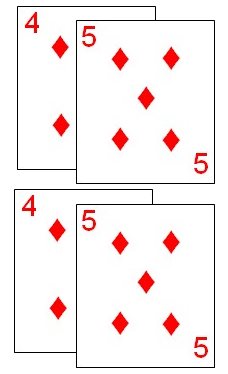
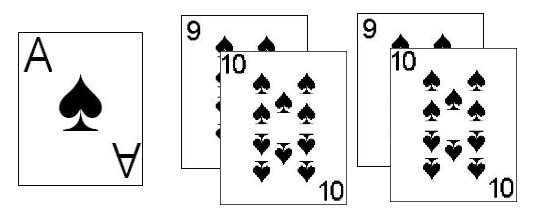 These may be combinations of some of the previous listed lead types, such as individual cards, sets or sequence of sets. All cards must, however, be of the same suit. The other players must then in turn play an equal number of cards to the trick. If possible, they must play the same number of identical cards as played by the leader to the trick, and all these cards must be of the same suit if possible. If they do not have the same number of cards of the same suit, they must play as many cards as they have of that suit and any other cards from the hand to complete a play of the same number of cards. If a player has no cards of the suit led, he may play a similar combination as led to the trick, but in the trump suit. If any other player has a combination that can beat a combination (in the same suit) played by the leader to a trick, that other player must show it immediately (even if out of turn), and the leader must change his lead, removing that combination of cards from the trick. For each card that the leader is forced to remove from the trick in this way, he must subtract 10 points from his score and the opposing team adds 10
points to their own score. This occurs after the hand is complete, since it may not yet be obvious which players are currently on the Trump Maker's team. The only way to beat the entire play is if any other player, not having any cards of the suit led, is able to play the same pattern of card combinations in the trump suit, which wins the trick. If two other players are able do play such a combination in the trump suit, the play containing the higher ranked cards is considered to be the highest.
These may be combinations of some of the previous listed lead types, such as individual cards, sets or sequence of sets. All cards must, however, be of the same suit. The other players must then in turn play an equal number of cards to the trick. If possible, they must play the same number of identical cards as played by the leader to the trick, and all these cards must be of the same suit if possible. If they do not have the same number of cards of the same suit, they must play as many cards as they have of that suit and any other cards from the hand to complete a play of the same number of cards. If a player has no cards of the suit led, he may play a similar combination as led to the trick, but in the trump suit. If any other player has a combination that can beat a combination (in the same suit) played by the leader to a trick, that other player must show it immediately (even if out of turn), and the leader must change his lead, removing that combination of cards from the trick. For each card that the leader is forced to remove from the trick in this way, he must subtract 10 points from his score and the opposing team adds 10
points to their own score. This occurs after the hand is complete, since it may not yet be obvious which players are currently on the Trump Maker's team. The only way to beat the entire play is if any other player, not having any cards of the suit led, is able to play the same pattern of card combinations in the trump suit, which wins the trick. If two other players are able do play such a combination in the trump suit, the play containing the higher ranked cards is considered to be the highest.